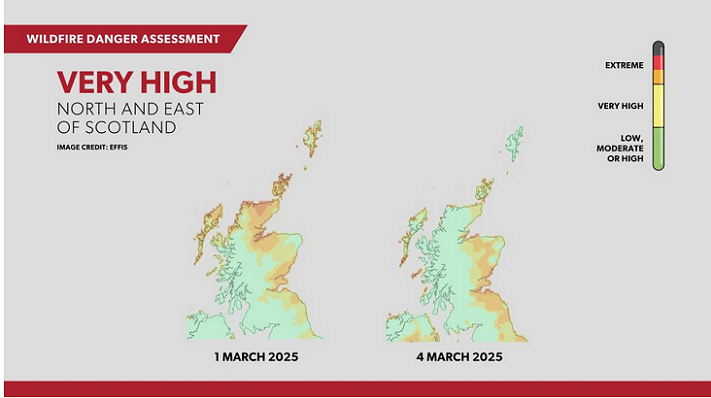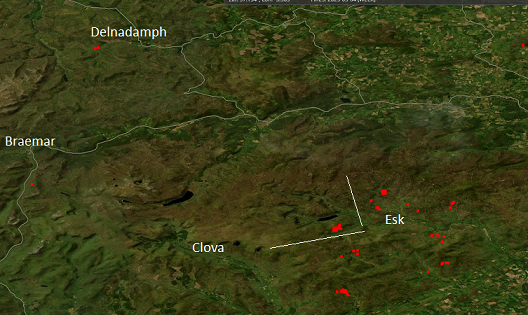
Following my post yesterday on King Charles’ muirburn at Delnadamph (see here), I am very grateful to Jamie Mann, an investigative journalist at the Ferret, for alerting me to NASA’s Fire Information for Resource Management System (FIRMS) database (see here). FIRMS records satellite observations of fires, however caused, across the world. Satellite technology now has a 50% chance of recording fires as small as 1m2 at night and 4m2 in the day.
FIRMS is a very rich source of information, showing the extent of fires across the world, including oil wells out to sea (145,000 gas flares detected 2013-23) and along with that a sense of how much carbon is being released into the atmosphere through open burning. It also allows anyone interested to track muirburn.
FIRMS confirms the muirburn which took place at Delnadamph last week (the red square to the left was on the Glenavon Estate):

FIRMS also provides evidence for all the other muirburn that has recently taken place in Scotland. From it you can see that the greatest concentration of fires over the last ten days, in both Scotland and the Cairngorms, has been in the Angus glens – mostly just outside the Cairngorms National Park boundary.

FIRMS shows the muirburn started in the Angus Glens on 27th and 28th February but increased significantly AFTER the SFRS issued their very high fire risk warning for the period 1st – 4th March. This proves that a significant number of other grouse moor owners, besides King Charles, allow their staff to ignore fire warnings and burn in very dry conditions, which is also contrary to the Moorland Code.
It provides further proof, as if more was needed, that the voluntary approach to improving grouse moor management simply doesn’t work. This evidence of reckless muirburn adds weight to the argument in my last post that the SFRS should be given the statutory power to ban ALL fires at times and in areas where they judge there to be a high fire risk. FIRMS would make it very easy for the SFRS to monitor and enforce such a ban
Moreover, once the muirburn licensing scheme has been introduced (see here) and the Moorland Code has been put onto a statutory footing, FIRMS would make it easy for Scottish Ministers to monitor other aspects of the code, from not burning on peatland to not burning in winds over 12mph (which was ignored by King Charles’ staff). All Scottish Ministers would need to do is combine the data from FIRMS with other data, such as the James Hutton Research Institute’s soil maps or the Met Office’s data on wind speed .
With all the new technology and the Scottish Government now employing a record number of civil servants (see here) – up by 1,800 staff in the last four years – its clearly not a lack of resources that is preventing the Scottish Minister responsible, Mairi Gougeon, from implementing the muirburn provisions of the Wildlife Management and Muirburn (Scotland) Act 2024. So why the delay?

The fact that all these fires were conducted safely with no excess burns, with no incident, makes my point in other posts on yesterdays Delnadamph blog that SFRS advice should be seen as just that ‘advisory’. What the FIRMS data shows is that in this local area conditions were actually good for ‘cool burning’, and that SFRS advice was no more than just that.
The implication that any ‘reckless’ burning took place is plain wrong and laughable.
I do agree the FIRMS data could be very useful to see if folk are burning out of season (which is statutory).
Nick, it would be interesting to know if you have actually been heather burning?
Hi Colin, the fact is that most recreational campfires, barbecues etc are “conducted safely with no excess burn, with no incident” but that does not make them sensible at times of high fire risk. I am submitting an FOI to SFRS on top of the one submitted for Delnadamph to find out how many of the instances of muirburn in the Angus Glens between 1st and 4th March were notified to them as per the Moorland Code and what their response was. I will return to some of your other points in further posts. Nick
Hi Nick,
You ask questions but you don’t answer ones I ask. I will ask again. It would be interesting to know if you have actually been heather burning? Yes or No?
If you haven’t then readers should take your blogs with a wee pinch of salt. You are of course entitled to your opinion on Muirburn but you have no experience of it and I think folk will necessarily conclude that you are otherwise motivated… on a political mission because you don’t like it. You don’t seem to even want to engage around all the positive reasons for conducting it, why not?
Regarding your FOI requests – you are welcome to waste SFRS time and public money on this but I hope they politely tell you to get lost. The Muirburn Code is ‘guidance only’. I quote from the opening summary first line of the last version issued by NatureScot
“The Muirburn Code provides good practice guidance for burning and cutting of vegetation”. One of its suggestions is to call SFRS if going burning but there is no mandatory requirement to do this. And let me tell you another thing which you would have known if you had been heather burning before writing on the topic.
In the glens where heather burning takes place SFRS is mostly dependent on a system of local volunteers. In our area the people doing the burning are the volunteers for SFRS, they are trained as part of their volunteering role. You see these are local interwoven communities. They don’t need to call a control room in some far off city. If you went heather burning you would learn this and the meaning of ‘community’ and what these folk do for a living.
Why don’t you write to King Charles and ask him if any of his team volunteer for SFRS?
Hi Colin, its seems you have not read my first post in this series where I highlighted the role gamekeepers played in stopping the Cannich Fire by burning a strip across the front of it. I have acknowledged the skills involved and the important role those practised in muirburn currently play in putting out fires – that doesn’t mean either that muirburn itself is right or that all those who practise it do so safely. No, I haven’t watched muirburning in person but so what? There are lots of other ways you can see and learn about what muirburn does. However, if you are open to discussing and hearing that other evidence/concerns I would be very happy to come out and see how you do it and we could also have a look at the consequences. How does that sound? Nick